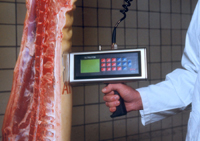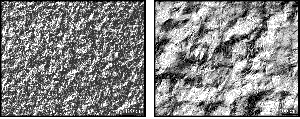Method
Produces Uniform, Self-Assembled Nanocells
|
|
The peaks on this three-dimensional
plot indicate a high concentration of liposomes forming
in a microchannel.
|
Nanotechnology
is about making improved products by building them from components
hundreds of times smaller than a human blood cell. But how do
you put things together at such a tiny scale? One way is to
create the right conditions, so that they assemble themselves.
For example,
a new method for producing uniform, self-assembled nanocells
has been developed by researchers at the National Institute
of Standards and Technology (NIST). Reported in the March 10
issue of the Journal of the American Chemical Society,
the method may have applications as an improved method for encapsulating
drug therapies. A patent application has been filed.
Current
bulk methods for producing nanocells called liposomes—a
type of artificial cell—produce particles in a wide range
of sizes. The sizes must be sorted and filtered before being
used for drug delivery, since dosage depends critically on size.
The new
NIST method uses micrometer-size channels etched into a device
to produce self-assembled liposomes of specific sizes from as
large as about 240 nanometers (nm) to as small as about 100
nm. A stream of natural fats (lipids) dissolved in alcohol—is
directed at an intersection of two channels that looks like
a micro version of a four-way stop. A water-based liquid containing
medicines or other substances is sent toward the lipid stream
from two opposing directions. Rather than mixing with the water,
the lipids surround it, forming self-assembled nanocells.
Controlling
flow rates in the microchannels produces nanocells of specific
sizes. Faster flows produce smaller cells. Medicine-filled liposomes
made in nanosizes should allow for more accurate drug delivery.
In particular, liposomes have been studied for years as a way
to concentrate the effectiveness of cancer chemotherapy while
minimizing harmful side effects.
Media
Contact:
Scott
Nance, (301) 975-5226


Electronic
Device Standards To Yield Choicer Chops
 |
A
worker measures the depth of back fat and the depth of the
"loin eye" or muscle (the good part of the pork
chop) using a hand-held ultrasonic device.
(Photograph courtesy of SFK Technology, Inc.) |
Choosing
the best chops, steaks or other fresh meat products is a tough
job. It's a delicate balancing of leanness, juiciness, taste,
marbling and more. Increasingly, meat processors use electronic
devices and equipment—such as optical probes, ultrasonic
sensors and digital cameras—to evaluate critical fat to
meat ratios. In 2003, for instance, electronic devices determined
pricing for more than 80 percent of the almost $7.5 billion worth
of swine processed in the United States. Multiple devices, as
well as different methods for evaluating results can, however,
produce different data.
The
National Institute of Standards and Technology (NIST) has joined
meat industry counterparts, producers, device manufacturers, the
United States Department of Agriculture (USDA) and ASTM International
(formerly the American Society for Testing and Materials) to standardize
the measuring process for pork, beef and, eventually, poultry.
In
February, ASTM committees, representing all concerned parties,
approved the first two of four draft standards to cover key aspects
of the electronic methods used to determine the value of live
animals, carcasses and individual cuts. The approved standards
outline requirements for installation, operator training, operation,
verification, inspection, maintenance, design and construction
of devices or systems. The remaining two standards, expected to
be approved in the spring of 2004, cover calibration, accuracy
and standardized equations for pricing meat. The final standards
are expected to be incorporated into new USDA regulations.
Richard
Suiter, NIST weights and measures coordinator and chair for an
ASTM subcommittee, says, “The new standards will increase
consistency and confidence in the measurements across technologies
and will benefit everyone—equipment manufacturers, producers,
packers and consumers."
Media
Contact:
John Blair, (301) 975-4261


Delving
into Defects Spurs Prospects for Chip Insulator
A warm winter coat doesn’t
work nearly as well if it’s full of holes. The same is
true for hafnium oxide, a promising insulator for the next
generation of smaller,
faster microchips.
While hafnium oxide prevents currents from leaking through
the ultrathin layers of semiconductor chips more than 1,000
times better than conventional silicon oxide, its prospects
have been dampened by too many current-draining defects.
Now a team
of National Institute of Standards and Technology (NIST) and
IBM researchers reports in the March edition of Electron
Device Letters that they have quantified these “electrical
capture defects” in a way that may help chipmakers reduce
the defects or at least devise a way around them.
NIST researcher
John S. Suehle called the team’s measurements
a “critical first step” for improving manufacturing
processes.
Using
a method called “charge pumping,” the
NIST and IBM scientists found where the defects occur near
the interface
between the silicon substrate and the hafnium oxide and how
those locations are ultimately detrimental to transistor operation.
The method involves applying a voltage pulse and then measuring
the current coming from a transistor. By changing the characteristics
of the voltage pulse used, the scientists were able to measure
the electrical-capture capacity of the defects.
Media
Contact:
Scott
Nance, (301) 975-5226


Homeland
Security Standards Help State/Local Governments
Featuring
contributions from NIST, newly adopted Department of Homeland
Security (DHS) standards for first-responder equipment and radiation
detectors provide state and local governments with clear guidance
to ensure that they purchase the best available gear for public
safety and counterterrorism personnel.
Coinciding
with the new department’s first anniversary,
DHS has announced its adoption of a set of eight standards
that provide performance requirements for respirators and
other critical personal protective equipment for first
responders.
For DHS, NIST’s Office
of Law Enforcement Standards is coordinating
accelerated efforts to develop specifications
for garments and other gear that protect against chemical,
biological, radiological, nuclear and explosive hazards.
A
second set of DHS-adopted standards—four in all—will
ensure that detectors ranging from hand-held alarming devices
to shipping-container-sized monitors will reliably discern above-background
levels of radiation. These standards are the products of a year-long,
NIST-led
collaboration of diverse government and private-sector organizations.
Media Contact:
Mark
Bello, (301) 975-3776


NIST
Study Helps Auto Engineers by the Numbers
 |
| These
optical micrographs show two surfaces with the same average
roughness values but dramatically different surface topographies. |
Using
rigorous statistical analysis, National Institute of Standards
and Technology (NIST) researchers identified a potential source
of error in the surface roughness data used in the automotive
industry to predict how friction affects production of metal
parts during forming.
With this improved analysis, automakers should be able to
more easily incorporate lighter weight materials in their
products and improve fuel efficiency.
The NIST scientists
presented their findings at the Society of Automotive Engineers’ World
Congress 2004, held in Detroit March 8-11.
The NIST researchers found industry often tries to draw
specific conclusions about the surface with mathematically
averaged roughness data that are too general.
They
also demonstrated that the current industrial practice for
interpreting surface roughness may produce the same roughness
values for two surfaces with markedly different topographies.
This could lead to inaccurate predictions of friction because
this surface roughness measurement only quantifies the average
peak heights and valley depths, not the spacing between them.
Friction is key in auto part production. Too little friction
during manufacturing leads to parts wrinkling and buckling.
Too much friction can cause parts to tear.
The NIST
team is continuing its work and is developing a new analytical
approach for industry use for more reliable predictions of
surface roughness and friction.
Media
Contact:
Scott
Nance, (301) 975-5226


Light
Wave Measurements Make Circuits Better
Talk
about precision. New measurements of key wavelengths of
ultraviolet light—down to a few millionths of a nanometer—are
among the most precise ever reported and are improving calibrations
of microlithography tools used in making integrated circuits
such as those in computer chips.
The dimensions involved are 10,000 times smaller than
hydrogen atoms, the smallest of all atoms.
To
make the measurements, physicists at the National Institute
of Standards and Technology (NIST) used a spectrometer so
sophisticated that it is one of only five of its kind in
the world, two of which are at NIST. The spectrometer, which
separates and detects specific wavelengths of light radiation,
provides 10 times better resolution than similar instruments
used in calibrations for highly demanding applications such
as the Hubble Space Telescope. The work is reported in the
February issue of the Journal of the Optical Society
of America B.
The
scientists measured the wavelengths of light emitted by
excited atoms of iron, germanium and platinum. These elements
are used as reference standards for calibrating argon flouride
(ArF) excimer lasers, among the latest tools for printing
integrated circuits on silicon wafers. ArF lasers are tunable
over a range of approximately 0.7 nanometer (nm) centered
at 193.4 nm. Precise calibration ensures that the laser
light is focused properly to produce the desired circuit
patterns. Improved calibrations are expected to help the
semiconductor industry make circuits smaller.
The measurements were partially funded by Lambda Physik,
a major supplier of lasers for microlithography applications.
The results have been incorporated into commercial laser
systems.
Media
Contact:
Laura
Ost, (301) 975-4034

Quick
Links
President
Presents Seven with Baldrige Awards—At a
March 9 ceremony, President George W. Bush and Commerce
Secretary Don Evans honored Medrad, Inc.; Boeing Aerospace
Support; Caterpillar Financial Services Corp. U.S.; Stoner,
Inc.; Community Consolidated School District 15; Baptist
Hospital, Inc.; and Saint Luke’s Hospital of Kansas
City with the 2003 Malcolm Baldrige National Quality Award
in recognition of their performance excellence and quality
achievements. This is the most Baldrige Award recipients
since the program started in 1988 and the first time that
recipients were named in all five (manufacturing, service,
small business, education and health care) Baldrige Award
categories. For details, see http://www.nist.gov/public_affairs/releases/baldrige2003.htm
Quest
for Excellence Conference XVI—The 16th annual
Quest for Excellence conference will be held March 28-31
in Washington, D.C. The conference provides a forum for
Malcolm Baldrige National Quality Award recipients to share
their exceptional performance practices with worldwide leaders
in business, education, health care and not-for-profit organizations.
For details, see http://www.nist.gov/public_affairs/confpage/new040328.htm


(Return
to NIST News Page)
Editor:
Gail Porter
Date
created: 3/11/2004
Date updated: 3/22/2004
Contact: inquiries@nist.gov

